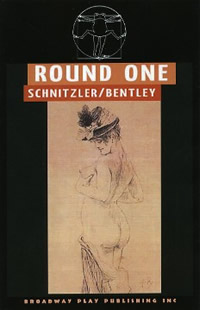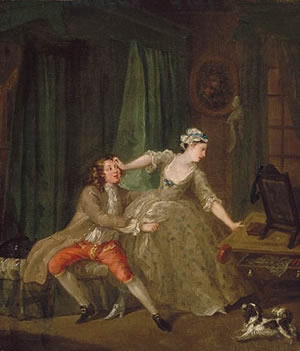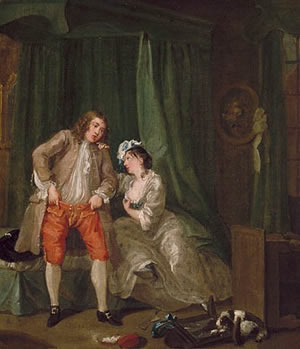
Round Two/Round One
By Eric Bentley
[The following essay is Eric Bentley's preface to a new
version of Arthur Schnitzler's play Reigen
(1900), published by Broadway Play Publishing Inc. in December
2008. Bentley was the translator for the first American production
of Reigen, titled La Ronde, at Circle in the
Square in 1955, and his new version, titled Round
One, is an adaptation of that translation. Bentley says
that Round One "also serves as a full-length prologue"
to Round Two, a play he wrote in 1986 that relocates
Schnitzler's action from 1890s Vienna to 1970s Manhattan. Round
Two was reissued by BPPI in June 2008. About the Viennese
author, Bentley writes: "On and off, throughout the twentieth
century and beyond, it was conceded, if often grudgingly, that
Arthur Schnitzler (1862-1921) was a major figure both in fiction
and in drama and, looking back today, one can confidently affirm
that Reigen was, and therefore is, a major work."]
----------------------------
Round One, in its day, provoked what was possibly the
biggest theater scandal ever. Here is what we find in the Deutsch-Österreichische
Tages-Zeitung, Vienna, April 24, 1922:
Lust for money and power were always
the driving force of all Jewish transactions. Productions of
Reigen have for a long time now been much more than
a business: they are a test of power through which Jewry (Juda)
wishes to show that in this age-old cultural center of the German
spirit it has taken to itself the power.
To whom then did Vienna belong--Schnitzler
or the Nazis? Sigmund Freud or Adolf Hitler? In 1938 the former
fled to a quiet death in London while the latter entered Vienna
in a triumphal march.
Of course productions of Reigen
were never a test of political or social power but the anti-Semites
should be thanked for finding more in Reigen than anyone
else did. Read properly, it does pack a punch. And it does speak
for a sophisticated sense of civilization that no fanatic of any
persuasion can accept. That Reigen shocks Puritans is
the least of it -- and the worst of it. The Tages-Zeitung
just cited provided the standard puritanical putdown:
The aim is not the satisfaction of artistic
needs but the exploitation of the easily-aroused erotic feelings.
Note here the double error: it is assumed,
first, that a work should not arouse erotic feelings and, second,
that Schnitzler's purpose was precisely to arouse such feelings.
The truth could not be more different.
Though in principle Schnitzler would not have objected to open
eroticism ("arousing erotic feelings") Reigen happens
to be a comedy, and comedy is apt to make fun of such feelings.
Schnitzler has even replaced the sexual act, in this play, with
asterisks on his page or a blackout on his stage. (Oscar Straus,
at one point, composed a pleasant Viennese waltz to be played
during this blackout.) Reigen is indeed so serious a
comedy that overserious readers, especially medical men, have
found in it a warning against "promiscuity" and unprotected sex
in a time of rampant syphilis. (Winston Churchill's father was
one of its many victims.) I might add that when I wrote Round
Two in the nineteen eighties, one serious reader said my
characters seemed to him to be passing AIDS along…
What is it that the characters in Round
One actually do? Each of them, as we say, "has sex" with
two partners and makes no full or sincere commitment to either
one. To the Tages-Zeitung that was both disgusting and
titillating -- a terrifying mix. To some critics, scholars and
physicians it was dangerous to the health and much needed the
exposure which, they felt, Schnitzler's play gave it. Two schools
of thought, or pseudo-thought, are here at odds with each other.
One sees Round One as the enemy in the great war of the
age, Aryans versus Semites. The other sees it as a potential friend
and ally in the current war against syphilis. Both take any production
of the play as an urgent socio-political act, if not an act of
war, at least an act in a war.
How wrong they both were! For this play
is not propaganda of any sort; it is not even didactic. That its
author, a medical man himself, must, in 1900, have been acutely
aware of the dangers of syphilis is true but such awareness is
not present in Reigen, and the notion that he may be
warning a future generation against AIDS is absurd. As to the
proto-Nazi attack in the Tages-Zeitung, Schnitzler might
have seen that coming, but it has not influenced the text of his
play. And when it came, and other troubles followed, Schnitzler
did not return the fire of the Nazis. He withdrew the play from
stages all over Europe: performances were not to be licensed for
the duration of his copyright. Thus Reigen had no presence
on the European stage until 1982.
The American stage is a different matter,
for the United States had very different copyright laws. This
part of the Reigen story begins in 1950 with a film of
which the title was a French translation of the word "Reigen":
La Ronde. Initially, the film was banned by the New York
authorities, not indeed as Semitic, but as indecent. It was a
Jewish attorney who took the case all the way to the Supreme Court
and won, much to the consternation of Roman Catholic officials
who saw in Reigen as great a threat to social stability
as the Viennese Nazis had.
The film was shown, at least in art houses,
all over the United States. Did this mean that Schnitzler's work
could at last emerge as what it was, a work of art, a comedy,
by a worthy contemporary of Shaw and Wilde? It had high credentials,
a cast of first rank French actors, and a director of great talent
and taste, Max Ophuls. But from here on I must cease to tell the
story from the outside and "objectively" because I was on the
inside.
I reviewed the Ophuls film in The New
Republic. Unfavorably. For though indeed this film was a
breakthrough of sorts, presenting Reigen as a work of
art, and not as any kind of propaganda or didacticism, I found
it untrue to the original, not in the spirit of the author. Schnitzler
abhorred the myth of Gay Vienna ("gay" in its traditional, not
its sexual, meaning), the frivolous Vienna of Strauss waltzes
in which the Danube is a mythical blue, its actual color in Viennese
territory being a dull brown. But Ophuls's film hewed all too
closely to that stereotype. It was, in every sense, too light.
Which fact enabled it to get by the Supreme Court but prevented
it bringing Schnitzler's clinical realism and rawness to the American
public.
At this time, I was in touch with Schnitzler's
son Heinrich, who was Arthur's heir and handled theatrical rights.
On the Ophuls film, his opinion was the same as mine or perhaps
I should say my opinion was the same as his as he had been lecturing
me about Arthur's disbelief in Gay Vienna for years. But when
I proposed to make a new translation of the play which would be
authentic Schnitzler he did not want it to be produced but stood
by his father's express wish that it be withheld from all theaters.
I would have respected Arthur's wishes except that I learned at
this time that the German text was not protected by U.S. copyright
law. I therefore assumed that if I did not offer a translation
to a theater someone else would. Arthur's wishes, in any case,
had not been a stipulation in his will, and I didn't feel I had
the same obligation to respect them as did his son and heir.
The rest is history. I made the translation
and offered it to the outstanding Off Broadway theater of the
time, Circle in the Square, "the Square" being Sheridan Square,
where it was produced by Theodore Mann and Jose Quintero. Quintero's
1955 direction of Reigen was not only a correction of
the Ophuls film. It was, in North America at least, the first
production of the play as a work of art, not more, not less, a
story the moving images of which define ten human beings, and
this not to titillate or enflame an audience, nor on the other
hand to teach them to use safe sex, but to amuse and entertain
them (this comedy is a comedy) and to present a Schnitzlerian
vision of things: in the midst of life we are in death, but in
the midst of death we are in life. Our audiences at Circle in
the Square left the theater rather sadly, I thought, though much
of the time during the actual performance they were smiling broadly
or even laughing loudly. And I found myself asking total strangers,
what has this play done for you, what would you say is its point,
if any, what does it add up to, if anything? Not all the responses
I got were single words, or even one-liners. Some had to be provided
in extenso in a neighboring bar. Let me attempt to extract the
essence of the more interesting replies:
First off, the form of Reigen,
the famous daisy chain, is paradoxical: the play is centered,
yet not centered, in the sexual act. This is the play all about
fucking, which is the play about anything but fucking: the sexual
act is off stage and thus unseen, while drama consists of what
you see on stage. So is Schnitzler playing a game with us? By
all means: was not a BBC-TV Schnitzler series entitled Games
of Love and Death? Death may not be prominent in Reigen
but is present in the shadows and notably in the first scene and
the last. Both the Soldier who starts the play and the Count who
finishes it are close companions of the Grim Reaper. What is more
prominent in the play is of course Love, that is, the idea or
hope (or despair) of Love. Love is on everyone's tongue but has
not reached anyone's heart.
The form of Reigen -- A in bed
with B, B with C, C with D, etcetera -- calls so much attention
to itself that people, including professional critics, have had
trouble seeing anything else and thus, in the press, we have often
found Reigen described as hardly a play at all. Did not
Schnitzler himself regard it as but a series of conversations?
In a letter, he even suggested it had no great literary pretension.
The conversations are structured, of course, being neatly arranged
in twos, the first leading to orgasm, the second away from orgasm.
Which might give Schnitzler a sound claim to originality in playwriting
except that critics who know their history will say No, this dual
structure is simply a derivation from two Hogarth paintings entitled
"Before" and "After."

Myself, I am inclined to concede
that these paintings may indeed have been Schnitzler's starting
point. But they are not more than that. Hogarth portrays a single,
if presumably typical, seduction. On his canvases we catch two
moments in the process and find out nothing more about the two
people involved, let alone about a third, fourth, or fifth person
in that environment. In Reigen we are confronted with
ten distinct human beings in a continuing action, with something
more than hints of their past and their future. At a first reading
or viewing, it may be that only the repetitions of this "plot"
are noticed but a second and third will reveal more and more.
One may note, for example, that while each character has two partners,
he (or she) does not have two similar partners, nor yet two partners
neatly contrasted with each other. In a character's first encounter,
you will find the seed of his (or her) second: the reason why
he or she needs or at least seeks a different kind of partner,
the differences all set forth in the dialogues. The way the upper-class
Husband, for instance, talks to his Young Wife in his first scene
prepares us for his choice of partner in his second scene: it
will be a Viennese type known as The Little Miss, a working class
girl who will not take money from the man who picks her up but
will gladly give him sex in return for dinner and drinks in a
good restaurant... And such a forward thrust also works backwards:
in a character's second scene, you also recognize the different
mask he or she wore in the first scene.

So you are making a mistake if you view
Reigen as a succession of asterisks or blackouts which
signify a succession of orgasms, but you are no closer to the
full truth of the matter if you view it as a circle or carousel
(i.e. movement in a circle), though of course this metaphor is
alive within the play. If the structure were indeed circular,
one would, at the end, be back at the beginning. But one is not.
The play opens with the encounter of Whore and Soldier. The latter
is the crudest character in the play, a man who has almost totally
given up his humanity. Other people exist just to provide him
with a physical release. Thus in the interplay of body and soul
which is the life of this play and the characters in it, he stands
at one extreme, and the Count in the last scene stands at the
other. The Count is so intent on proving that the soul is more
real than the body that he actually forgets he has had sex with
the whore and fantasizes about a conceivable relation, even with
a whore (!), that is "romantic," i.e. spiritual. Thus Reigen
has what most commentators have denied it: a development of plot
and theme from one extremity to another.
And what gives this development its justification:
its energy and its point? It is a variation or serious parody
of a standard pattern: the development of sinners from their fleshly
sins and commitments upwards toward heaven and all things spiritual.
Shades of Wagner's Tannhäuser and a thousand lesser works!
For the spirituality of the Count, though well meant, is not authentic.
He thinks he hasn't "had sex," but he has. And when he realizes
this, he can only regret that reality is less attractive than
illusion and look forward to his next talk with his philosophical
friend Lulu (Louis) who perhaps can find a form of words that
will perform a miracle...
As to the Before and After pattern, every
scene except the last (which presents the After but not the Before)
does conform to it, and thus if sexual intercourse were the goal,
all the characters could be deemed successful, even the Count
whose intercourse is forgotten. But very evidently, intercourse
was not the goal, and none of them feel successful, except possibly
the Soldier of Scene One who in a cynicism that betokens despair
has abandoned not only all hope of happiness but even the dream
of it. All the others do dream of it, and speak of love as what
would produce happiness. Love in what sense? Love mostly undefined
and vague, as befits a dream. Through orgasm to love -- that is
one underlying formula -- the hope that, through orgasm, one might
arrive at love. One can of course hope for love with a less pretentious
aim in view: simple intimacy. And what the people of Vienna and
Reigen are seeking in all those beds is intimacy. Only
the Soldier is incapable of it. The others achieve it in different
degrees and styles. Even the Whore can manage a degree of it when
she has a civilized partner like the Count.
"Only connect" -- famous formula of E.M.
Forster. Sexual intercourse thinks of itself as the ultimate connection.
Parental coition gave birth to all of us, so we feel entitled
to expect some benefit from almost any bedroom encounter. We get
to be disappointed. What can be the most intimate and loving connection
is often, perhaps usually, and in Vienna 1900 always, loveless
and even if very exciting ("that was terrific sex!") spiritually
empty, leaving the coupling couple strangely and negatively affected.
Conversations following sex (of which Schnitzler has here provided
ten examples) define the "degrees of separation" between the parties.
They may think of themselves as sensual, even lecherous, but actually
they are people who hope that sensuality or even a mere pretense
of it and the ability to fuck will end their isolation, their
insulation.
They are insulated, yes, each of them marooned
on his own little island. Arthur Schnitzler once remarked that
the title of one of his other plays would also fit Reigen.
It is Der einsame Weg, The Lonely Way.
